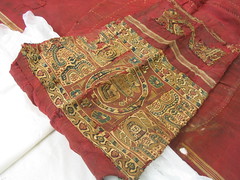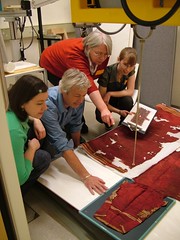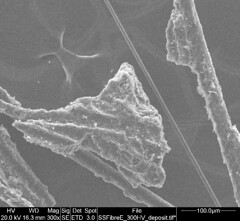By Stuart Frost and Elin Simonsson
 I posted a blog entry about a conservation work on an eighth century tunic in the V&A’s collections in June 2007. A great deal of work has taken place since then. The red wool tunic, with appliqué tapestry decoration, is a rare survival. It was excavated from a burial ground in Egypt in the late nineteenth century and has been in the V&A collections since 1891 after it was purchased from a dealer. Click on the detail to the right for more information about the object.
I posted a blog entry about a conservation work on an eighth century tunic in the V&A’s collections in June 2007. A great deal of work has taken place since then. The red wool tunic, with appliqué tapestry decoration, is a rare survival. It was excavated from a burial ground in Egypt in the late nineteenth century and has been in the V&A collections since 1891 after it was purchased from a dealer. Click on the detail to the right for more information about the object.
From around the third century AD onwards, as Egypt became a Christian society, burial practices changed. Bodies were no longer mummified but were laid to rest dressed in clothes. Many of these textiles were preserved in the dry burial conditions and tunics such as this one were found when the burial grounds were excavated. Although the V&A tunic is in better condition than many of the other textiles excavated at the time, there are many gaps in what we know about this garment. The archaeological techniques used in the nineteenth century were not as thorough as they are today. Excavations were often rushed and minimal information was recorded.
 To bridge some of these gaps a scientific analysis of the tunic was carried out earlier this year. The recent analysis explored the pattern of staining and aimed to provide more specific information relating to the tunic’s age and provenance. The analysis involved a range of different cutting-edge methods, including X-radiography, ultraviolet and infrared photography, scanning electron microscopy, and gas chromatography-mass spectrometry. The research has arisen through a collaboration between the V&A and Archaeological Sciences, Bradford University. Elizabeth-Anne Haldane, Senior Textile Conservator at the V&A, and Sara Gillies, MSc student at Bradford University have been working together. Although the results are still being analysed there are already some interesting findings from the work.
To bridge some of these gaps a scientific analysis of the tunic was carried out earlier this year. The recent analysis explored the pattern of staining and aimed to provide more specific information relating to the tunic’s age and provenance. The analysis involved a range of different cutting-edge methods, including X-radiography, ultraviolet and infrared photography, scanning electron microscopy, and gas chromatography-mass spectrometry. The research has arisen through a collaboration between the V&A and Archaeological Sciences, Bradford University. Elizabeth-Anne Haldane, Senior Textile Conservator at the V&A, and Sara Gillies, MSc student at Bradford University have been working together. Although the results are still being analysed there are already some interesting findings from the work.
The use of a range of scientific techniques worked very well. The results have complemented each other and have helped build up a more complete picture of the tunic’s life-story.
The tunic is covered in a variety of different stains. A dark brown-green stain, with a red-orange centre, was identified on the inside back of the tunic. Analysis of a sample of these dark deposits revealed degraded cholesterol and fatty acids.These stains were probably created when the body decomposed. As the body inside the garment rotted fluids seeped through the tunic leaving areas of staining.
The V&A garment has some unusual horizontal striped stains not found on comparable textiles. Scientific analysis showed that these are similar to other stains on the tunic in terms of chemical composition. The pattern of staining was probably determined by how the body and the garment were laid out in the grave. As the body decomposed it is likely that the fluids gathered in pools and were compressed within the textile by the weight of the body.
Mapping the location of the stains has helped to determine the orginal appearance of the tunic. It has become obvious that the tunic was altered after excavation to improve its appearance, probably by the dealer from who the tunic was acquired. The tunic was let down at the waist and some of the appliqué decoration has been moved.
 Isotopic analysis will be carried out later to determine more precisely where the yarns or threads for both the tunic and the tapestry decoration were made. This is a fairly new method for determining the origin of a garment and is based on the idea that the ratios of light isotopes (carbon, nitrogen and oxygen) in wool fibres vary between locations. Wool fibres from different areas will have a unique combination of light isotopes. Samples from the main woven textile body of the tunic will be compared with the applied tapestry decorations as this may indicate whether or not the two parts come from the same location. They will also be compared with modern and archaeological samples of known provenance.
Isotopic analysis will be carried out later to determine more precisely where the yarns or threads for both the tunic and the tapestry decoration were made. This is a fairly new method for determining the origin of a garment and is based on the idea that the ratios of light isotopes (carbon, nitrogen and oxygen) in wool fibres vary between locations. Wool fibres from different areas will have a unique combination of light isotopes. Samples from the main woven textile body of the tunic will be compared with the applied tapestry decorations as this may indicate whether or not the two parts come from the same location. They will also be compared with modern and archaeological samples of known provenance.
If you would like to find out more about the scientific analysis of the tunic, further information will be published in Spring 2009 in Issue 57 of the V&A Conservation Journal. If you have any questions or queries please post them below and I’ll do my best to obtain the answers.
Many thanks to Sara Gillies and Elizabeth-Anne Haldane for providing a summary of their work the scientific analysis of the Coptic tunic, and to Elin Simonsson for collating information for this blog-entry.
Click here to read the V&A’s Conservation Journal online.
To see a film about the conservation of the tunic follow the link given below:
http://www.vimeo.com/6175424